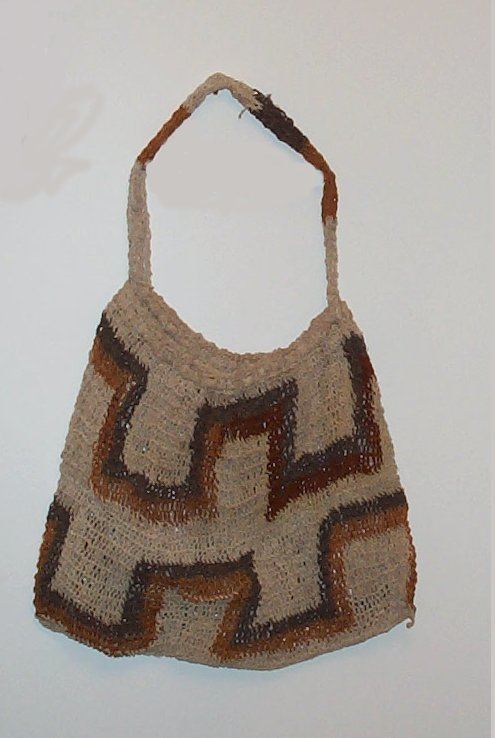 | ||
A bilum is a string bag made by hand in Papua New Guinea. The bag can be made by a process known as looping or knotless netting or by crocheting. Traditionally, the string used was handmade, normally from plant materials. Now, however, many people who can afford to do so make their bilums from store bought yarn and string.
Bilums are used to carry a wide range of items, from shopping goods in large bilums to personal items in purse-sized varieties. Mothers often carry their babies in bilums.
Whilst the traditional method of making bilums using woven plant reeds is still widely spread across Papua New Guinea, many villagers are now finding it easier to use wool-based yarns to make their bags. This allows a greater diversity of color schemes to be incorporated into the making of the bilums, and as a result they are more highly sought after, due to their highly visible and different patterns and color combinations.
Local men usually prefer to use long handle styles so they can be worn over the shoulder, freeing their arms for more important issues, like carrying important bush knives or to grab onto things while hiking mountains. Women often prefer the short handled versions that they can sling across their foreheads to carry greater loads, such as babies and/or large quantities of foodstuff (yams/potatoes/kau-kau etc.)
Either way, there is now a definite swing to the more vivid color/patterning styles that afford the bearer to be more distinctive in making his/her fashion statement.
The concept of bilums are very marketable overseas, and a French company has registered Bilum as a trademark, which it uses for its lines of bags made from recycled building fronts giant advertising sheets, car seatbelts and airbags, and other plastic materials.
They come in different patterns, each pattern resembling certain tribe or clan. More complex and specific patterns are made for carrying during public appearances or displayed during the ceremonial events. The special ceremonial events include yam festivals, tambuan dances, bride price payment, dead compensation and barter system between the river people and the inland wosera people. The complex patterns are of inheritance and only very few ladies in a village possess those inherited talents. The Wosera people are the only tribe that maintains the originalities of the bilum patterns and treasures the complexity of their inherited patterns and it is the only significance of that area.
The bilum concept has spread quite quickly down to the coast and then up to the Highlands in the last decade especially when women in noncircular business identified bilum making as a source of regular income. In the highland region they have extended the bilum concept to make bilumwares especially bilum dresses and skirts. The bilumware is now becoming common during school graduation dressings. Bilumware is now marketable to Papua New Guinea citizens living overseas.
